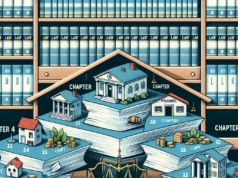
In recent months, significant developments in bankruptcy protection laws have emerged, prompting widespread discussion among legal experts, financial advisors, and individuals facing financial distress. These changes aim to address the evolving economic landscape, particularly in light of the ongoing repercussions of the global pandemic and inflationary pressures. This article delves into the key changes in bankruptcy protection laws, their implications for both individuals and businesses, and essential resources available for those navigating this complex terrain.
Understanding the New Bankruptcy Protection Laws: Key Changes Explained
Recent legislative reforms have introduced several key changes to bankruptcy protection laws, designed to streamline the process and provide greater relief to debtors. One of the most notable changes is the increase in the debt limits for Chapter 11 filings, allowing more small businesses to access this form of bankruptcy protection. Additionally, the introduction of a new, expedited process for Chapter 13 bankruptcy aims to reduce the time and complexity involved in repaying debts. Furthermore, provisions have been added to enhance consumer protections, including measures that prevent aggressive collection tactics during the bankruptcy process. These changes reflect a broader commitment to making bankruptcy a more accessible and less daunting option for those in financial distress.
The Impact of Recent Legislation on Individuals and Businesses Facing Bankruptcy
The recent legislative changes have far-reaching implications for both individuals and businesses grappling with bankruptcy. For individuals, the increased debt limits and streamlined processes mean that more people can seek relief without the fear of losing their homes or essential assets. Businesses, particularly small enterprises, now have an improved pathway to restructure their debts and emerge from bankruptcy more effectively. This shift not only aids in preserving jobs but also contributes to the overall economic recovery by allowing viable businesses to continue operations. However, experts caution that while these changes provide more options, they also require individuals and business owners to be more informed and proactive in their financial planning.
Navigating the Complexities of Bankruptcy Protection: A Step-by-Step Guide
Navigating the complexities of bankruptcy protection can be daunting, but understanding the process can alleviate some of the stress. The first step is to assess your financial situation comprehensively, including debts, assets, income, and expenses. Next, it is crucial to consult with a qualified bankruptcy attorney who can provide tailored advice based on your circumstances. Once you have decided on the appropriate bankruptcy chapter to file, you will need to gather necessary documentation, including tax returns and financial statements. After filing, a meeting of creditors will be scheduled, where you will answer questions about your financial situation. Finally, completing the required credit counseling and financial management courses will be essential for receiving a discharge of debts. Each step is critical, and careful attention to detail can significantly impact the outcome of your bankruptcy case.
Common Misconceptions About Bankruptcy Protection: What You Should Know
Despite its growing accessibility, several misconceptions about bankruptcy protection persist, often deterring individuals from seeking help. One common myth is that filing for bankruptcy will ruin your credit score permanently; while it does have an initial negative impact, many individuals find that their credit scores improve over time as they rebuild their financial health. Another misconception is that all debts are dischargeable in bankruptcy; however, certain obligations, such as student loans and child support, typically remain unaffected. Additionally, some believe that bankruptcy means losing all assets, but many individuals can retain essential property through exemptions. Understanding these misconceptions is vital for making informed decisions about financial recovery.
Essential Resources and Support Systems for Those Considering Bankruptcy
For individuals contemplating bankruptcy, numerous resources and support systems are available to guide them through the process. Nonprofit credit counseling agencies offer free or low-cost services to help individuals assess their financial situation and explore alternatives to bankruptcy. Additionally, legal aid organizations provide assistance to low-income individuals seeking bankruptcy protection, ensuring that everyone has access to legal representation. Online resources, including government websites and financial education platforms, can also offer valuable information about the bankruptcy process and rights. Furthermore, support groups and forums can provide emotional support and shared experiences from others who have navigated similar challenges, creating a sense of community during a difficult time.
Future Trends in Bankruptcy Protection: What Experts Are Predicting
Looking ahead, experts predict several trends that may shape the future of bankruptcy protection. One anticipated trend is the continued evolution of digital tools and online platforms that facilitate the bankruptcy process, making it more accessible and efficient. Additionally, as economic conditions fluctuate, there may be a rise in specialized bankruptcy options tailored to specific industries, particularly those heavily impacted by economic downturns. Experts also foresee a growing emphasis on financial literacy and education, equipping individuals and business owners with the knowledge to make informed decisions about their finances before reaching the point of bankruptcy. Finally, ongoing discussions about reforming bankruptcy laws to better reflect the realities of modern financial challenges suggest that further changes may be on the horizon, aiming to enhance protections for vulnerable populations.
In conclusion, the recent developments in bankruptcy protection laws represent a significant shift in how individuals and businesses can seek relief from financial distress. By understanding the key changes, navigating the complexities of the process, and utilizing available resources, those facing bankruptcy can find a pathway to recovery. As the economic landscape continues to evolve, staying informed about future trends and potential reforms will be crucial for anyone considering bankruptcy as a viable option for financial relief.




















